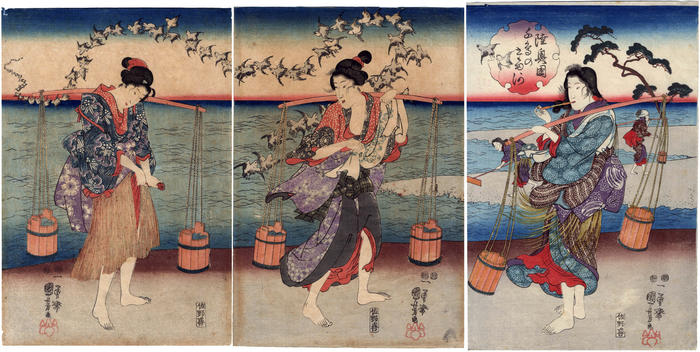Utagawa Kuniyoshi (歌川国芳) (artist 11/15/1797 – 03/05/1861)
Plover Jewel River in Mutsu Province (Mutsu no kuni Chidori no Tamagawa - 陸奥国千鳥のたま河)
ca 1847 – 1848
28.5 in x 9.5 in (Overall dimensions) Japanese color woodblock print
Signed: Ichiyūsai Kuniyoshi ga
一勇斎国芳画
Artist's seal: kiri
Publisher: Sanoya Kihei
(Marks 446 - seal 25-210)
Censors: Mera and Murata
British Museum
Museum für angewandte Kunst, Vienna - center panel only
Muzeum Sztuki i Techniki Japońskiej Manggha, Krakow
Philadelphia Museum of Art - the left panel only
Dallas Museum of Art
Van Gogh Museum - central panel only
National Museums of Scotland - right panel
National Museums of Scotland - middle panel
Yale University Art Gallery - center panel only
Lyon Collection - another copy of this triptych
Jordan Schnitzer Museum of Art - the right-hand panel only
Los Angeles County Museum of Art "Three women are collecting brine in yoked buckets to make salt. Two more women can be seen farther off, one with pails, the other raking salt flats. A flock of plovers rises from the waters and flies off into the distance in a long, winding formation. As with other versions of the subject by Kuniyoshi, the aim was to present working women in alluring poses expressive of exertion and exhibiting a slight dishabille... A figure very similar to the woman wringing out her wet red undergarment occurs in a surimono print of almost twenty years earlier...
The theme of women collecting salt has been combined in this triptych with the ancient subject of 'Six Jewel Rivers' (Mu-tamagawa). The six rivers, at various locations throughout Japan, are celebrated in classical poems for their beauty. By Kuniyoshi's day they had also become the subject of popular songs and dances. 'Plover Jewel river' (Chidori no Tamagawa), also known as the Noda Jewel river, links the towns of Shiogama ('Salt Kiln', a name reflecting the river's historical connections with salt-making) and Tagajō in modern Miyagi prefecture, where it flows into the Pacific."
Quoted from: Kuniyoshi from the Arthur R. Miller Collection by Timothy Clark, p. 162. There is a color illustration on pp. 162-3.
****
The significance of chidori in Japanese art, history and culture
Merrily Baird wrote in her book Symbols of Japan... "The word chidori - usually translated as plover - refers to several migratory shorebirds that transit Japan in spring and autumn. Chidori in flight have been a favored theme of art and poetry for more than a thousand years, and the birds appear on lacquerware, kimono, sword furnishings, ceramics, and netsuke. Portrayed in large numbers and in highly stylized manner, they are usually paired with waves, rivers, shorelines, or fishing nets."
In several regards, the chidori is an auspicious symbol for the warrior class. The first ideograph used to write the word means "one thousand," and the second is a homophone for the words "seize" an "capture." Because the bird overcomes high waves and strong winds to migrate, it is seen as an emblem of perseverance and the conquering of obstacles. Finally, it is associated with the legendary hero Yamato Takeru, whose body and soul are said to have taken flight after his death as a giant white chidori..."
****
There is another copy of the right-hand panel in the Ashmolean Museum at the University of Oxford.
****
Plovers are not only known as chidori, but also as sanderlings
Below the triptych we have added a Harunobu print from ca. 1766-67 showing 'The Jewel River of Plovers, a Famous Place in Mutsu Province' (Chidori no Tamagawa, Mutsu meisho - 千鳥の玉川 陸奥名所). It contains a poem composed by the priest Nōin (能因 998-1050).
The poem reads:
Yū sareba
shiokaze koshite
Michinoku no
Noda no Tamagawa
chidori naku nari
Evening descends
as winds from the sea
blow across Jewel River
of Noda in Michinoku
where flocks of plovers cry.
Translated by John Carpenter
David Waterhouse gave a slightly different translation
When evening comes the
salt-laden winds pass over
Michinoku, and
on the Crystal River at
Noda the sanderlings cry.
Waterhouse added: "Michinoku is an old name for Mutsu Province, comprising the northern tip of Honshū (roughly, modern Aomori Prefecture)."
****
Illustrated:
1) in black and white in Ukiyo-e Masterpieces in European Collection 5: Victoria and Albert Museum II, Kodansha, 1989, page 170, #34.
2) in color, the center panel only, in the Catalogue of the Van Gogh Museum's Collection of Japanese Prints by Charlotte van Rappard-Boon, Willem van Gulik and Keiko van Bremen-Ito, 1991, p. 245, #345.
3) in color over two pages in Kuniyoshi from the Arthur R. Miller Collection by Timothy Clark, Royal Academy of Arts, 2009, pages 162-163.
Sanoya Kihei (佐野屋喜兵衛) (publisher)
landscape prints (fūkeiga 風景画) (genre)
beautiful women (bijin-ga - 美人画) (genre)
mitate-e (見立て絵) (genre)
